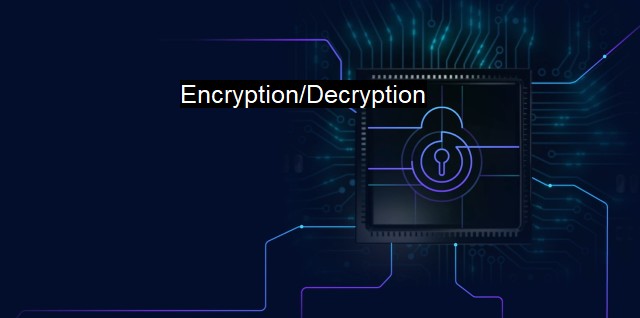What is Encryption/Decryption?
Importance of Encryption and Decryption in Cybersecurity: Protecting Digital Communication and Data
Encryption and Decryption are two principle components of cryptography, a vital field that assumes an indispensable role in cybersecurity. These elements have been used as a shield against cyber attacks since contemporary times. As we all know, the digital universe is ceaselessly facing threats from different components. Whether it's a huge organization's confidential information file, an employee's identity or a user's banking details, everything is at stake in this cyber world. The magnificent duo under discussion, encryption-decryption, offer a robust answer for the defense against these threats, functioning as an imperative of cybersecurity and antivirus field.To comprehend the concept of encryption-decryption, one has to, fundamentally understand their individual definitions and then, consider these sequential operations. Encryption is a process that transforms comprehensible data, known as plaintext, into an uninterpretable format known as ciphertext. By using specific algorithms and mathematical equations, each piece of the provided plaintext transforms into a code or cipher that's akin to Potter's cryptic parlance to the muggles-it looks familiar but makes no sense.
Encryption's broader application intention is to conceal data so that nobody except the authorized receiver can make sense of it. This process helps to communicate information securely over an insecure path such as the internet. Hence, the encryption process ensures that confidentiality, data integrity, non-repudiation, and authenticity are maintained. The role of a 'key' in this process cannot be neglected. In this case, the key is a piece of information that controls the result of the cipher's operational function.
Encryption is only half the battle won. The data meant to be protected is accessible in transformed or encrypted data. It should also be converted back into comprehensible or plaintext. Hence, Decrypting, the opposite of encrypting, comes into play. Decrypting is the process of reversing the encrypted or cipher text back into plaintext.
The decryption process uses a specific 'decryption key,' that's typically only available with the authorized receiver. Despite the fact that an unauthorized recipient can have the ciphertext, the decryption algorithm influences it to be impossible for them to change it back into plaintext, or partway impossible without the necessary decryption key.
The interplay of encryption and decryption forms the base for numerous cybersecurity and antivirus protocols. As a matter of fact, their functions become no less than a bane for the hackers trying to access, change, or take advantage of data unlawfully. they are unequivocally vital to establishing secure communication over the internet.
On another note, modern encryption-decryption, thanks to the application of computational intelligence, machine learning, and artificial intelligence, has climbed to heightened sophistication, which even clogs some of the most brute hacker force methodologies.
Encryption/decryption is not confined to cybersecurity or antiviral programs. Its application spans across e-commerce sites that need to protect transaction details, wireless communications, especially Wi-Fi networks, cloud storage and data servers, Virtual Private Networks (VPN), email services, messaging apps, etc. Basically, any kind of data transmitted over the network if encrypted and decrypted properly ensures user privacy and data security.
Encryption and Decryption together form an invincible defense mechanism against threats distributed over virtual borders. These mechanisms naturally fit within the broader context of mask, cloak, armor, or shield; or metaphorically, the 'cyber shield,' providing a milieu of safety in an evermore predatorial techie jungle.
In the end, the encryption-decryption process shines brightly as a dazzling beacon of cybersecurity, defending against the relentless siege waged by individuals and groups harboring malicious intent against personal, corporal, or even national security.

Encryption/Decryption FAQs
What is encryption?
Encryption is the process of converting plain text or data into a coded language to prevent unauthorized access to sensitive information. This process ensures that sensitive data can only be accessed by authorized users with the appropriate decryption key.What is decryption?
Decryption is the process of converting encoded or encrypted data back to its original form, making it readable and accessible to authorized individuals. The decryption process requires a decryption key or password to unlock the encrypted data.Why is encryption important in cybersecurity?
Encryption plays a vital role in cybersecurity as it provides an additional layer of security to protect sensitive information from being intercepted, stolen, or compromised by unauthorized parties. Even if a hacker gains access to encrypted data, without the proper decryption key, the information remains unreadable and useless.How does antivirus software use encryption and decryption?
Antivirus software uses encryption and decryption to protect against malware and viruses. It encrypts the signature of known malware and decrypts suspicious files to identify whether they match the encrypted signature. If a match is found, the antivirus software can quarantine or remove the infected file before it has a chance to harm the system.Related Topics
Cryptography Malware analysis Vulnerability assessment Intrusion detection Phishing prevention
| | A | | | B | | | C | | | D | | | E | | | F | | | G | | | H | | | I | | | J | | | K | | | L | | | M | |
| | N | | | O | | | P | | | Q | | | R | | | S | | | T | | | U | | | V | | | W | | | X | | | Y | | | Z | |
| | 1 | | | 2 | | | 3 | | | 4 | | | 7 | | | 8 | | |||||||